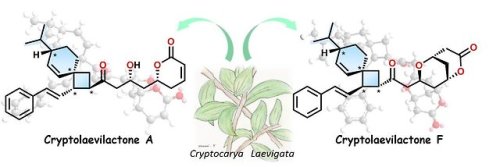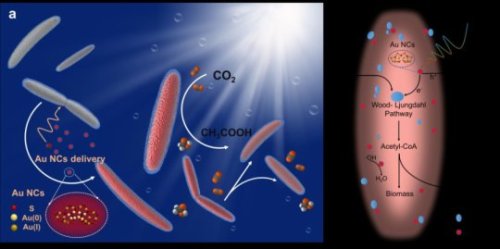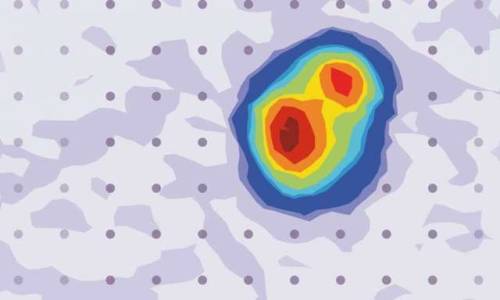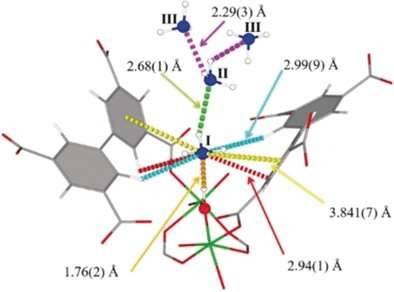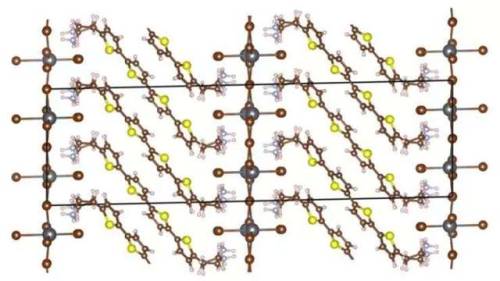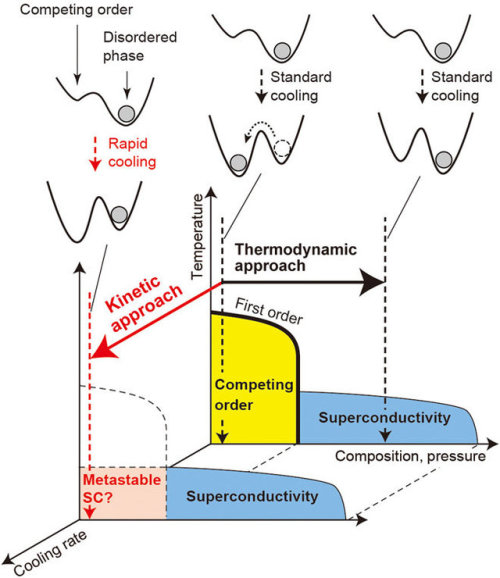#science
Let it rain! New coatings make natural fabrics waterproof
Fabrics that resist water are essential for everything from rainwear to military tents, but conventional water-repellent coatings have been shown to persist in the environment and accumulate in our bodies, and so are likely to be phased out for safety reasons. That leaves a big gap to be filled if researchers can find safe substitutes.
Now, a team at MIT has come up with a promising solution: a coating that not only adds water-repellency to natural fabrics such as cotton and silk, but is also more effective than the existing coatings. The new findings are described in the journal Advanced Functional Materials, in a paper by MIT professors Kripa Varanasi and Karen Gleason, former MIT postdoc Dan Soto, and two others.
“The challenge has been driven by the environmental regulators” because of the phaseout of the existing waterproofing chemicals, Varanasi explains. But it turns out his team’s alternative actually outperforms the conventional materials.
“Most fabrics that say ‘water-repellent’ are actually water-resistant,” says Varanasi, who is an associate professor of mechanical engineering. “If you’re standing out in the rain, eventually water will get through.” Ultimately, “the goal is to be repellent—to have the drops just bounce back.” The new coating comes closer to that goal, he says.
Post link
Closing the gap: On the road to terahertz electronics
Asymmetric plasmonic antennas deliver femtosecond pulses for fast optoelectronics
A team headed by the TUM physicists Alexander Holleitner and Reinhard Kienberger has succeeded for the first time in generating ultrashort electric pulses on a chip using metal antennas only a few nanometers in size, then running the signals a few millimeters above the surface and reading them in again a controlled manner.
Classical electronics allows frequencies up to around 100 gigahertz. Optoelectronics uses electromagnetic phenomena starting at 10 terahertz. This range in between is referred to as the terahertz gap, since components for signal generation, conversion and detection have been extremely difficult to implement.
The TUM physicists Alexander Holleitner and Reinhard Kienberger succeeded in generating electric pulses in the frequency range up to 10 terahertz using tiny, so-called plasmonic antennas and run them over a chip. Researchers call antennas plasmonic if, because of their shape, they amplify the light intensity at the metal surfaces.
Post link
Electrospun sodium titanate speeds up the purification of nuclear waste water
Electrospun sodium titanate speeds up the purification of water based on selective ion exchange – effectively extracts radio-active strontium
With the help of this new method, waste water can be treated faster than before, and the environmentally positive aspect is that the process leaves less solid radio-active waste.
The properties of electrospun sodium titanate are equal to those of commercially produced ion-exchange materials.
“The advantages of electrospun materials are due to the kinetics, i.e. reaction speed, of ion exchange,” says Risto Koivula, a scientist in the research group Ion Exchange for Nuclear Waste Treatment and for Recycling at the Department of Chemistry at the University of Helsinki.
Post link
Australian shrub contains new class of organic compound
The botanical world can be an exciting place for chemists. Plant species produce a beautiful array of organic molecules with complex structures, often of great practical use. Indeed, this is a realm where new discoveries are still being made. Recently, a Japanese-led research team discovered an entirely new structural class in compounds from a jungle-dwelling shrub.
The glossy or red-fruited laurel (binomial name: Cryptocarya laevigata) inhabits the rainforests of eastern Australia. Little was known about the chemical makeup of this tall shrub until the team, led by Kanazawa University, analyzed an extract of its twigs and leaves. The plant’s essential oil was found to contain a family of six new compounds, the structural analysis of which revealed some surprises.
As reported in Organic Letters, NMR experiments showed that at the center of the compounds lay a peculiar, nine-membered carbon cycle known as a spiro-nonene. This structure consists of two rings of carbon atoms—one containing six atoms, the other four—linked by a single “pinch point” atom that is a part of both rings. This motif had never been seen before in any natural product.
Post link
The culprit of some GaN defects could be nitrogen
As silicon-based semiconductors reach their performance limits, gallium nitride (GaN) is becoming the next go-to material to advance light-emitting diode (LED) technologies, high-frequency transistors and photovoltaic devices. Holding GaN back, however, is its high numbers of defects.
This material degradation is due to dislocations—when atoms become displaced in the crystal lattice structure. When multiple dislocations simultaneously move from shear force, bonds along the lattice planes stretch and eventually break. As the atoms rearrange themselves to reform their bonds, some planes stay intact while others become permanently deformed, with only half planes in place. If the shear force is great enough, the dislocation will end up along the edge of the material.
Layering GaN on substrates of different materials makes the problem that much worse because the lattice structures typically don’t align. This is why expanding our understanding of how GaN defects form at the atomic level could improve the performance of the devices made using this material.
A team of researchers has taken a significant step toward this goal by examining and determining six core configurations of the GaN lattice. They presented their findings in the Journal of Applied Physics.
Post link
This bacterium gets paid in gold
Harvesting solar fuels through a bacterium’s unusual appetite for gold
A bacterium named Moorella thermoacetica won’t work for free. But UC Berkeley researchers have figured out it has an appetite for gold. And in exchange for this special treat, the bacterium has revealed a more efficient path to producing solar fuels through artificial photosynthesis.
M. thermoacetica first made its debut as the first non-photosensitive bacterium to carry out artificial photosynthesis in a study led by Peidong Yang, a professor in UC Berkeley’s College of Chemistry. By attaching light-absorbing nanoparticles made of cadmium sulfide (CdS) to the bacterial membrane exterior, the researchers turned M. thermoacetica into a tiny photosynthesis machine, converting sunlight and carbon dioxide into useful chemicals.
Now Yang and his team of researchers have found a better way to entice this CO2-hungry bacterium into being even more productive. By placing light-absorbing gold nanoclusters inside the bacterium, they have created a biohybrid system that produces a higher yield of chemical products than previously demonstrated. The research, funded by the National Institutes of Health, was published on Oct. 1 in Nature Nanotechnology.
Post link
Saturn’s largest moon may hold key to cleaner engines
A new discovery on Titan’s haze is revealing new information about burning fuels on Earth.
Florida International University chemist Alexander Mebel and a team of international researchers have been studying Saturn’s largest moon, trying to unlock a mystery brewing beneath Titan’s thick, hazy atmosphere—How is it that dunes of hydrocarbons exist on the moon’s frozen surface?
On Earth, the kinds of hydrocarbons that cause soot are only known to occur during the combustion process under very high temperatures. They are the kinds of byproducts that engineers usually try to eliminate when engines burn fuel.
By examining data from NASA’s Cassini-Huygens probe, the researchers determined hydrocarbons can form the type of complex chains that create Titan’s orange-brown haze layers at temperatures as low as 90 degrees Kelvin, which is about -298 degrees Fahrenheit—that’s nearly 330 degrees below freezing on Earth.
Post link
Approach paves way for new generation of antimicrobial materials
Researchers at North Carolina State University have successfully incorporated “photosensitizers” into a range of polymers, giving those materials the ability to render bacteria and viruses inactive using only ambient oxygen and visible-wavelength light. The new approach opens the door to a range of new products aimed at reducing the transmission of drug-resistant pathogens.
“The transmission of antibiotic-resistant pathogens, including so-called ‘superbugs,’ poses a significant threat to public health, with millions of medical cases occurring each year in the United States alone,” says Reza Ghiladi, associate professor of chemistry at NC State and co-corresponding author of a paper on the work. “Many of these infections are caused by surface-transmitted pathogens.
"Our goal with this work was to develop materials that are self-sterilizing, nontoxic and resilient enough for practical use. And we’ve been successful.”
“A lot of work has been done to develop photosensitizer molecules that use the energy from visible light to convert oxygen in the air into biocidal 'singlet’ oxygen, which effectively punches holes in viruses and bacteria,” says Richard Spontak, distinguished professor of chemical and biomolecular engineering, professor of materials science and engineering at NC State and co-corresponding author of the paper. “There is no resistance to this mode of action.
Post link
3-D printing hierarchical liquid-crystal-polymer structures
Biological materials from bonetospider-silk and wood are lightweight fibre composites arranged in a complex hierarchical structure, formed by directed self-assembly to demonstrate outstanding mechanical properties. When such bioinspired stiff and lightweight materials are typically developed for applications in aircraft, automobiles and biomedical implants, their manufacture requires energy and labor-intensive fabrication processes. The manufactured materials also exhibit brittle fracture characteristics with difficulty to shapeandrecycle, in stark contrast to the mechanical properties of nature. Existing polymer-based lightweight structure fabrication is limited to 3-D printing, with poor mechanical strength and orientation, while highly oriented stiff polymers are restricted to construct simple geometries. In an effort to combine the freedom of structural shaping with molecular orientation, 3-D printing of liquid-crystal polymers was recently exploited. Although desirable shape-morphing effects were attained, the Young’s modulus of the soft elastomers were lower than high-performance liquid-crystal synthetic fibers due to their molecular structure.
To fully exploit the shaping freedom of 3-D printing and favorable mechanical properties of molecularly oriented liquid-crystal polymers (LCP), a team of scientists at the Department of Materials, ETH Zürich, proposed a novel approach. The strategy followed two design principles that are used in nature to form tough biological materials. Initially, anisotropy was achieved in the printing process via self-assembly of the LCP ink along the print path. Thereafter, complex-shaping capacity offered by the 3-D printing process was exploited to tailor the local stiffness and strength of the structure based on environmental loading conditions. In the study, Silvan Gantenbein and co-workers demonstrated an approach to generate 3-D lightweight, recyclable structures with hierarchical architecture and complex geometries for unprecedented stiffness and toughness. The results are now published in Nature.
Post link
Let there be light
The vials shown here contain a molecule that researchers can activate with light to affect biological processes in mammals. It’s part of a class of potential smart drugs that are under development to treat ailments including diabetes, blindness, and the side effects of chemotherapy. Because the molecules turn on only when hit with a certain wavelength of light, researchers can control when and where the compounds are active in the body. This photo was taken by Dusan Kolarski, a graduate student at the University of Groningen in the lab of Ben Feringa, who won the 2016 Nobel Prize in Chemistry for his work on molecular machines. Feringa’s group is working to create antibiotics that can be activated with light and thus may pose a lower risk of bacterial resistance. The team also wants to make water-soluble motors for applications in photopharmacology.—ALEXANDRA TAYLOR
Submitted by Dusan Kolarski
Do science. Take pictures. Win money. Enter our photo contest here.
Related C&EN Content:
Photoswitchable drugs could light the way to more targeted treatments
Flipping A Light Switch For Antibiotics
Light-activated gel releases insulin for potential diabetes treatment
Post link
A mysterious insulating phenomenon in a superconductor
Leiden physicist Milan Allan and his group have discovered an apparent paradox within a material that has zero electrical resistance. They report trapped charges, although charges should, in theory, keep flowing in the absence of resistance. The discovery could provide a missing piece of one of the big puzzles in physics today—high-temperature superconductivity. The results are published in Nature Physics.
A material can either be insulating or conductive. In an insulator, an extra electron will get trapped. Thus, no electric current flows in insulators. In a conductor, extra electrons will immediately flow. The more conductive the material is, the faster the electrons will flow.
The research group of Leiden physicist Milan Allan was therefore surprised to discover charge trapping in a material with zero resistance. Charge trapping is supposed to be a telltale sign of an insulator. Together with Leiden theoretical physicist Jan Zaanen, Allan’s group found that the phenomenon could unravel a longstanding mystery about charge transport in a family of materials called cuprates. These poorly understood materials have no resistance, even at relatively high temperatures, and are therefore labeled high-temperature superconductors. The mechanism behind those is one of the big mysteries in physics today.
Post link
A robust material for the uptake and storage of ammonia at densities that come close to that of the liquefied gas
Handling, storing, and shipping of ammonia requires costly equipment and special precautions because of its inherent corrosiveness and toxicity. Scientists in Manchester, UK, have found that a metal–organic framework, MFM-300(Al), a porous solid, not only effectively filters harmful nitrogen dioxide gas, but it also has outstanding capabilities for ammonia storage. As detailed in the journal Angewandte Chemie, reversible uptake and release of ammonia proceeds by a unique sorption mode.
Ammonia is an essential nitrogen source for plants and it is a basic chemical. This indispensable chemical, which is manufactured on a large scale from atmospheric nitrogen and hydrogen, has been called “bread from air”. But how should this resource be stored and handled? The gaseous or liquefied form is corrosive and toxic. Storing and shipping under pressure or at low temperatures is costly and energy-consuming. Adsorption in porous solids, such as zeolites or metal–organic frameworks—a strategy currently being tested extensively in hydrogen storage—could be an interesting option.
The robust metal–organic framework MFM-300(Al) has been shown to be a potent filter for nitrogen dioxide, which is a harmful pollutant in air. Martin Schröder and his colleagues at the University of Manchester, UK, have now scrutinized MFM-300(Al) for its ability to take up ammonia. They discovered that it could take up gaseous ammonia up to a density that comes close to that of liquid ammonia under ambient conditions. At around zero degrees Celsius it even surpassed this density.
Post link
Extracting energy from a 60 nanometers thin layer
A team of researchers have demonstrated the viability of the direct piezoelectric effect in a thin film Bismuth Ferrite Material for the first time. The work, published in Nanoscale entitles “Direct and Converse Piezoelectric Responses at the Nanoscale from Epitaxial BiFeO3 Thin Films Grown by Polymer Assisted Deposition” which has gained the cover letter of such journal.
[…]
In this particular research, the BFO was scanned in a novel methodology named “Direct Piezoelectric Force Microscopy” DPFM, a new AFM mode invented in 2017
(https://www.nature.com/articles/s41467-017-01361-2 ). The material in this mode is stressed by the AFM tip with nanometric size. The tip applies a force in the range of hundreds of microNewton and measures the generated charge that is created by the material. For the case of BFO material, the piezoelectric characteristics were collected when the tip crosses antiparallel domain configurations, see the following video for a 3D representation of the tip crossing such configuration: https://youtu.be/ir3W2Vk8hCs
Post link
Supercomputer predicts optical and thermal properties of complex hybrid materials
Materials scientists at Duke University computationally predicted the electrical and optical properties of semiconductors made from extended organic molecules sandwiched by inorganic structures.
These types of so-called layered “hybrid organic-inorganic perovskites"—or HOIPs—are popular targets for light-based devices such as solar cells and light-emitting diodes (LEDs). The ability to build accurate models of these materials atom-by-atom will allow researchers to explore new material designs for next-generation devices.
The results appeared online on October 4 in Physical Review Letters.
"Ideally we would like to be able to manipulate the organic and inorganic components of these types of materials independently and create semiconductors with new, predictable properties,” said David Mitzi, the Simon Family Professor of Mechanical Engineering and Materials Science at Duke. “This study shows that we are able to match and explain the experimental properties of these materials through complex supercomputer simulations, which is quite exciting.”
Post link
Graphene controls surface magnetism at room temperature
Typically research has focused on the effects induced by different materials in graphene. Convinced that this is only half the story, Dr Zeila Zanolli turned the tables to look at the proximity effects of graphene on magnetic semiconducting substrates. Using first principles calculations she observes a switching of internal spin alignment from antiferromagnetic to ferromagnetic. Persisting close to room temperature, her findings could find applications in magnetic memories or spin filters.
[…]
In a refreshing change of perspective, theoretical physicist Dr Zeila Zanolli has looked at the proximity effects of graphene on a magnetic semiconducting substrate, finding it to affect the substrate’s magnetism down to several layers below the surface. Her paper was published on 5 October in Physical Review B. She was also one of three recipients of the first MaX Prize for frontier research in computational materials science.
Post link
Polymers: Polyphenylene oxide
Though its technical name is poly(2,6-dimethylphenylene oxide) it is most commonly known as poly(phenylene oxide) or PPO. A condensation polymer, the polymerization of PPO produces water as a byproduct. It is a type of polyphenylene and is often grouped alongside polyphylene ethers as well.
PPO is one of many high-performance polymers known as engineering thermoplastics. These polymers have higher glass transition temperatures, making them temperature resistant. However, these polymers are often more crystalline, and therefore more brittle. In order to help with processing of PPO and to increase the toughness, almost all commercially available forms of the polymer are blended with polystyrene (such as high-impact polystyrene, or HIPS).
Applications of PPO (or, more commonly, blends of PPO and polystyrene) include those shown on the chart above. PPO is often used in applications where a polymer is desired but high heat resistance is also necessary, such as certain structural applications, electronics, and medical equipment (such as sterilizable instruments). Another common usage is in air separation membranes for the generation of nitrogen, an application which uses hollow fibers to create a membrane.
Sources/Further Reading: ( 1 - image 1 ) ( 2 - image 2 ) ( 3 - image 3 ) (4) (5)
Post link
Forcing a metal to be a superconductor via rapid chilling
A team of researchers with the RIKEN Center for Emergent Matter Science and The University of Tokyo, both in Japan, has found a way to force a metal to be a superconductor by cooling it very quickly. In their paper published on the open access site, Science Advances, the group describes their process and how well it worked.
Scientists around the world continue to seek a material that behaves as a superconductor at room temperature—such a material would be extremely valuable because it would have zero electrical resistance. Because of that, it would not increase in heat as electricity passed through it, nor lose energy. Scientists have known that cooling some materials to very cold temperatures causes them to be superconductive. They have also known that some metals fail to do so because they enter a “competing state.” In this new effort, the researchers in Japan have found a way to get one such non-cooperative metal to enter a superconductive state anyway—and to stay that way for over a week.
Post link
Copper ions flow like liquid through crystalline structures
Materials scientists have sussed out the physical phenomenon underlying the promising electrical properties of a class of materials called superionic crystals. A better understanding of such materials could lead to safer and more efficient rechargeable batteries than the current standard-bearer of lithium ion.
Becoming a popular topic of study only within the past five years, superionic crystals are a cross between a liquid and a solid. While some of their molecular components retain a rigid crystalline structure, others become liquid-like above a certain temperature, and are able to flow through the solid scaffold.
In a new study, scientists from Duke University, Oak Ridge National Laboratory (ORNL) and Argonne National Laboratory (ANL) probed one such superionic crystal containing copper, chromium and selenium (CuCrSe2) with neutrons and X-rays to determine how the material’s copper ions achieve their liquid-like properties. The results appear online on Oct. 8 in the journal Nature Physics.
“When CuCrSe2 is heated above 190 degrees Fahrenheit, its copper ions fly around inside the layers of chromium and selenium about as fast as liquid water molecules move,” said Olivier Delaire, associate professor of mechanical engineering and materials science at Duke and senior author on the study. “And yet, it’s still a solid that you could hold in your hand. We wanted to understand the molecular physics behind this phenomenon.”
Post link
Novel use of NMR sheds light on easy-to-make electropolymerized catalysts
In the world of catalytic reactions, polymers created through electropolymerization are attracting renewed attention. A group of Chinese researchers recently provided the first detailed characterization of the electrochemical properties of polyaniline and polyaspartic acid (PASP) thin films. In AIP Advances, the team used a wide range of tests to characterize the polymers, especially their capacity for catalyzing the oxidation of popularly used materials, hydroquinone and catechol.
This new paper marks one of the first pairings of standard electrochemical tests with nuclear magnetic resonance (NMR) analysis in such an application. “Because these materials can be easily prepared in an electric field and are cost-effective and environmentally friendly, we think they have the potential to be widely used,” said Shuo-Hui Cao, an author on the paper.
Although PASP has shown excellent electrocatalytic responses to biological molecules, newer areas of inquiry have explored the material’s ability to lower the oxidational potential in oxidation-reduction reactions. Reducing the oxidation potential is key for finding further uses for two materials used extensively as raw materials and synthetic intermediates in pharmaceuticals, hydroquinone and catechol.
Post link
Let’s hop this simple solution sticks around (x) | follow@the-future-now
Medi-gel
Looks like Mass Effect was rightSharing this because I want to see more about it and how it works.
Post link




